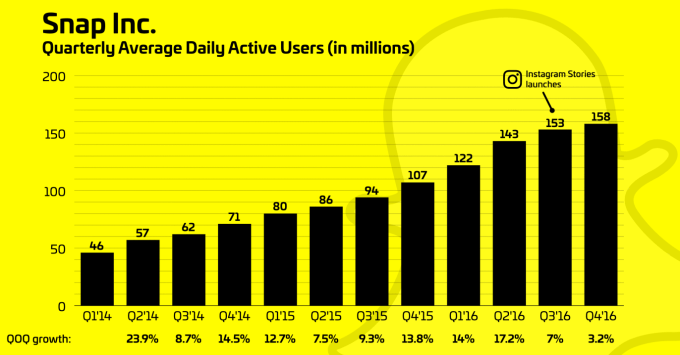Snapchat invented its best products by being the anti-Facebook. Its disappearing chats made visual communication quick and casual compared to Facebook’s email-esque text messages. Stories ditched the likes and permanency so you could share your raw moments in the now, instead of just the life highlights that define you forever on your Facebook Timeline.
But now this “opposite of Facebook” orthodoxy is holding Snapchat back. After a brutal year of being copied by the world’s biggest social network, Snapchat might be wise to return the favor.
Twitter and Instagram prove out the algorithm
Twitter was once in Snap’s position. With slowing growth, it needed a big change to reinvigorate its aging app and make it easier for people who don’t browse tweets constantly. Twitter had always been the real-time firehose of commentary about what’s going on right now. Yet over the years, as users followed more and more accounts, their best friends and the best tweets were drowned in the rushing river of their purely reverse-chronological feeds.

The result has been Twitter’s first meaningful growth in many quarters, adding 9 million users in Q1 2017. “We further refined the timeline to display a broader set of Tweets from a person’s network and applied deep learning models to show the most relevant Tweets first . . . These changes improved retention across both MAU and DAU” Twitter wrote in the quarter’s letter to investors.
Instagram pulled off a similar product coup this year. Previously it showed you every picture and video posted by people you followed in reverse-chronological order. Since these posts take up much more room in the feed, it was easy for one trigger-happy user on vacation or at an event to suddenly dominate the timeline and suppress everyone else. Meanwhile, it subtly discouraged people from posting multiple times per day for fear of having this spammy impact on their friends’ feeds.
Then Instagram switched to a relevancy-sorted algorithmic feed. It’s growth rate spiked, sharing per user increased, and Instagram has added 200 million monthly active users since to reach 700 million.
In both cases, going algorithmic seemed antithetical to the core identity of the services, and long-time users vocally griped that their apps were ruined…but they weren’t. Twitter wants you to know what’s going on in the world. Instagram wants you to see what’s going on with your friends and interests. Both missions are better accomplished when you see the most relevant content first, no matter how often or little you open the apps.
Snapsort
Now it’s Snapchat that needs an algorithmic boost. On May 10th it will have its first earnings call, and all eyes will be on its daily active user count. Snap Inc will try to trumpet every other possible statistic: minutes spent in app per user per day, percentage of users who post each day, video views, revenue per user. But Wall Street wants scale, not just depth of engagement, and there’s a proven way to get it.

This sorting also enables Instagram Stories to employ auto-advance, showing one friend’s photos and videos after another in a constant stream. You can watch in descending order of relevance until you get bored, and be confident the Stories you didn’t get to are from people you care about less. If you only follow a small number of friends, your besties come first. If you follow a ton of celebrities or interest accounts, your favorites won’t get lost.
Compare that with the experience on Snapchat, and the fact that its growth rate declined by 82% to a trickle after Instagram Stories launched makes sense. Snapchat shows you the big list of Stories from people you follow in reverse-chronological order. Users who post most often dominate the top slots and your attention, regardless of whether you ever actually open and watch their Stories.
There might have been more benefit to the unsorted strategy when Snapchat was a smaller network. Reverse-chrono ranking makes it easy to see if any friends are doing something fun right this minute that you might want to join. And when Snapchat was still just for hip early-adopter teens, you might not have followed anyone you didn’t want to watch. But as Snapchat became the defacto teen messaging app and everyone that everyone knew signed up, courtesy and social contract obliged people to follow even their more boring acquaintainces. The network dilluted, and your favorite people started getting overshadowed by the rest.
Without algorithmic sorting, auto-advance meant you’d basically be haphazardly watching in order of whoever posted most recently, bouncing from distant acquaintances to celebrities to friends. So last year, Snapchat dropped auto-advance. That made the experience even worse, and much more laborious. Now you have to watch one person’s story at a time and then bounce back to the list to find more, manually cobble together an adhoc Story Playlist that plays in sequence, [Update: or tap the Playlist button to watch all the Stories. It became tougher to have a lean-back viewing experience.]

If Snap doesn’t want to suddenly throw away the old feed, it could leave a reverse-chrono list below the new algorithmic one. Or it could just create a “Best Friends” or “Favorites” or “Recently Watched” section above your Stories list that groups together what the algorithm would have shown first. That section could potentially auto-advance too.
While Snap is known to favor CEO Evan Spiegel’s instincts over data, the app should at least run some sizable tests to see how people react. Digiday reports that it spent 2016 talking to publishers about potentially ranking them with a curation algorithm.
But at that time, pre-Instagram Stories, Snapchat was flying high and didn’t need to fix what wasn’t broken. The game has changed since. Snapchat users might have asked for faster horses, but Instagram gave them the automobile. Snap needs to modernize. It can still be about living in the now even if that’s not what it shows first.































Comment